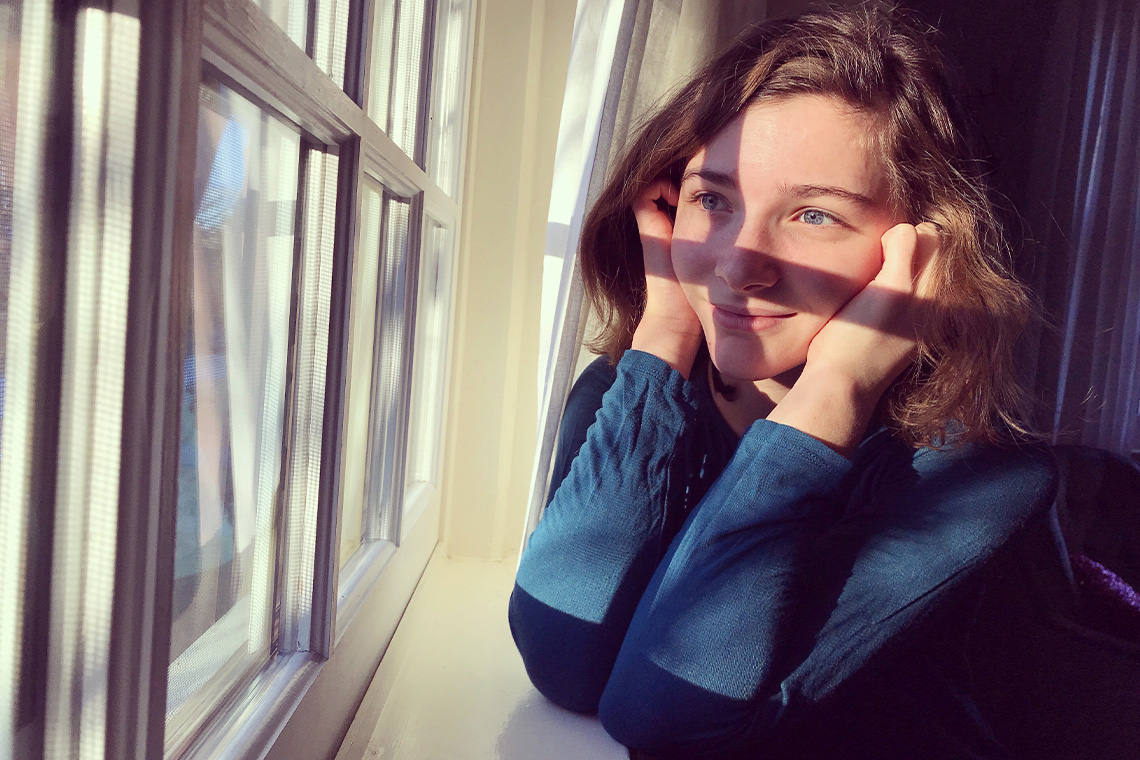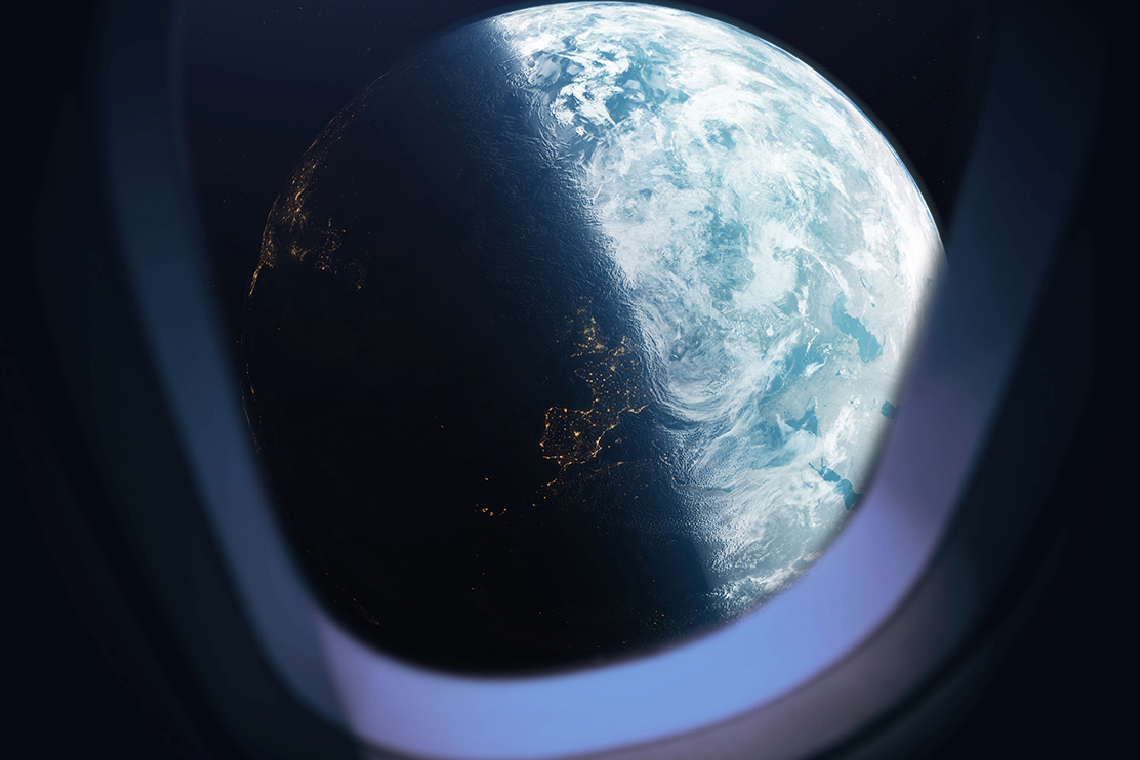Minds On
The centre of our solar system
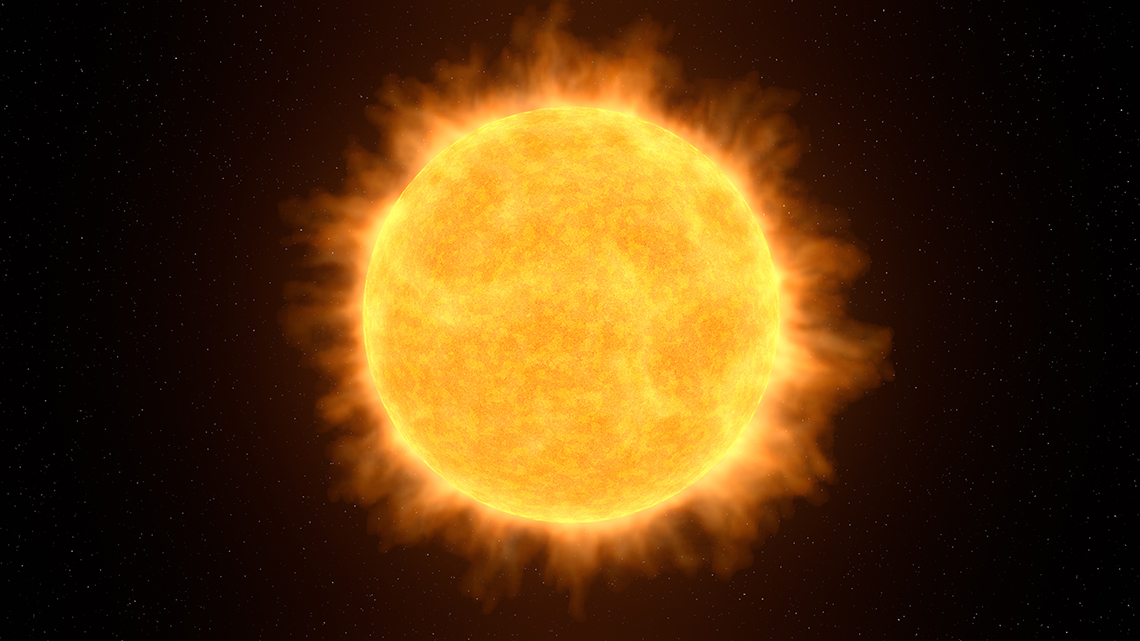
The Sun can be considered the most important part of our universe. It is a star, a very hot ball of gas and plasma, and the centre of our solar system. It’s so big that everything orbits around it because of its strong gravitational pull.
The Sun is the largest emitter of light in space and without it everything we know would not exist.
Can you list all of the ways that the Sun affects our everyday lives?
Examine the following images to give you some clues to create your list.
Action
Innovation in Canada
This learning activity features emerging technologies, STEM contributions, and Canadian innovations that are making a difference.

The Sun and Earth
The Sun plays many important roles in our daily lives. Aside from giving us warmth and light, it is responsible for many cycles in our lives.
Press the following tabs to learn more about the role of the Sun in many different cycles that directly impact life on Earth.
As Earth orbits around the Sun, it also spins round and round so that different parts of the globe are directly facing the sun at different times of the day. The side that is facing the Sun experiences day, while the side that is turned away from the Sun experiences night. As the Earth spins, the Sun’s light hits different parts of the globe causing “sunrises” and “sunsets.” It takes 24 hours for the Earth to complete one full spin or rotation. This is what causes day and night.
Check out this video clip to examine the rotation of the Earth as it orbits around the Sun producing the cycle of day and night.
Why is a calendar year 365 days? Because of the Earth’s orbit around the Sun! But did you know that it actually takes 365.25 days for the Earth to complete its orbit around the Sun?! It’s because of the extra quarter day that we have a leap year (with an extra day – February 29th) every four years!
Check out this video clip from “NASA Now: Reasons for the seasons” to learn more about why we have four seasons on Earth and if there are other planets that also have seasons.
Spotlight on the Sun
Check out this NASA video entitled “One Year on Earth – Seen from 1 million miles” to learn more about some amazing space technology, the EPIC camera, and some of the effects of the Sun in our life on Earth. As you examine the video, try and identify the tilt in Earth’s axis as observed over the passage of time (Hint: note the position of Africa over the course of the video clip. Does its position change?)
Did You Know?
What is an Aurora?
Do you know what an Aurora is and what causes this amazing phenomenon in the night sky?
Check out this video entitled “What is an Aurora?” to learn more about this mysterious nighttime occurrence and its relationship to the Sun!
Solar eclipses
Safety
Please note that staring directly at the sun can lead to serious eye damage. Even regular sunglasses are not enough protection! If you would like to observe the Sun, ask a trusted adult to help you obtain special glasses or guide you with other methods to safely observe the Sun.
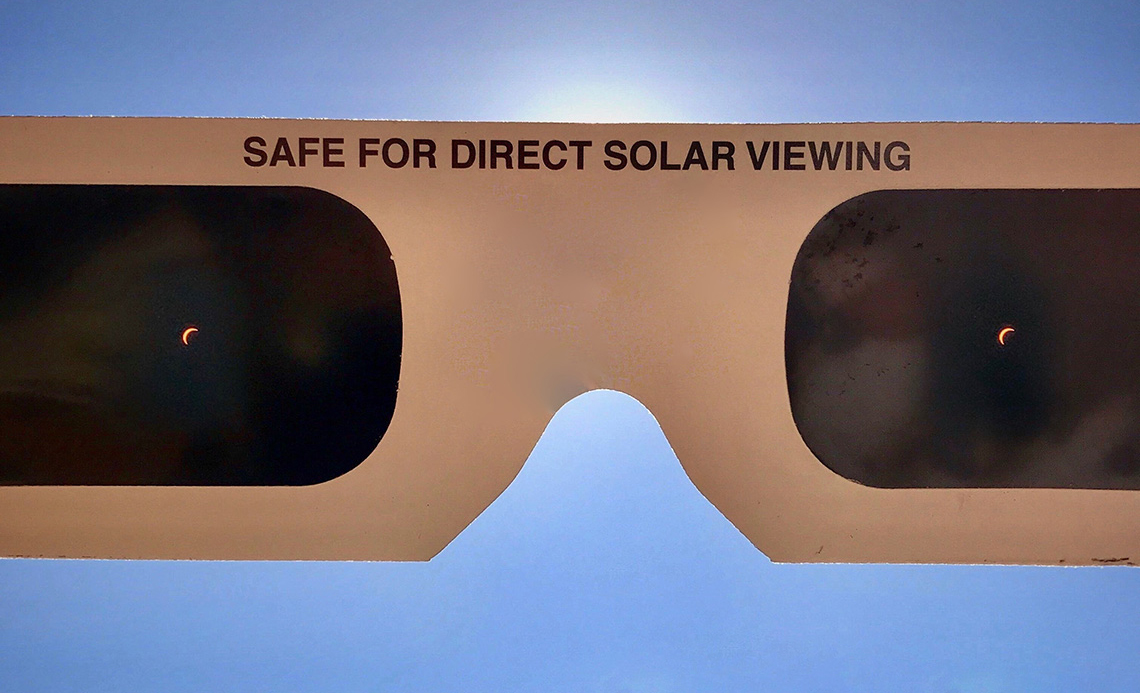
Disposable safety glasses used to watch a solar eclipse. Written on them is “Safe for direct solar viewing”. Through both of the lenses, a crescent solar eclipse is displayed.
A solar eclipse is an incredibly amazing occurrence! It happens when the Moon’s orbit passes directly in between the Sun and Earth, casting a large shadow on parts of our planet and blocking out part, or all, of the Sun’s light.

The Sun, Moon, and Earth lined up in a row with the rays of the Sun partially being blocked by the Moon preventing them for reaching a portion of the Earth.
There are three different types of solar eclipses that can occur:
- A partial eclipse – where the Sun is never completely covered by the Moon, so sections of its light are still visible.
- An annular eclipse – when the Moon’s orbit is closer to the Sun, so the Moon appears smaller from Earth leaving a visible ring of light around the outside of its shape.
- A total eclipse – when the moon completely covers all parts of the Sun.
Examine the following image that shows the position of the Moon over the Sun in each of the three types of eclipses.

The three types of solar eclipses. First, a partial eclipse showing a grey-coloured Moon blocking most but not all of the Sun, leaving a crescent of the sun visible. Next an annular eclipse, showing a thin ring of yellow visible around the circumference of the grey-coloured Moon. Lastly, a Total eclipse, showing a very, very thin ring of light-grey visible around the circumference of the dark grey Moon. Label this “Total Eclipse”.
For an example of what happens during a total eclipse, explore the following animation.
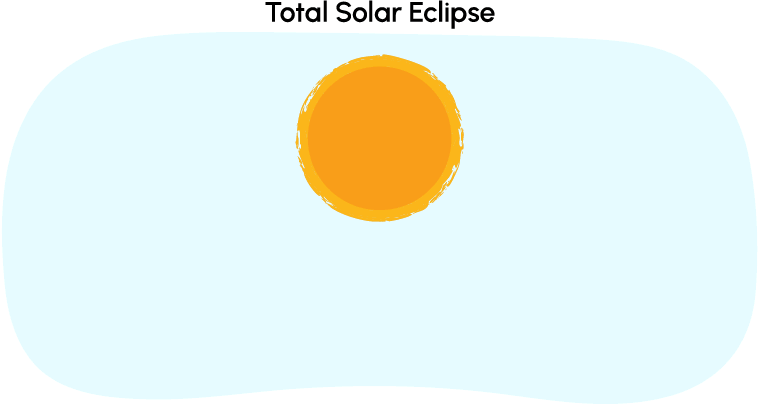
Brainstorm
Brainstorm
Consider the following and record your thinking using a method of your choice such as in print, digitally, or using an audio recording.
While multiple eclipses often happen within a year, whether or not you will be able to observe one depends on where in the world you are. A solar eclipse can only occur in places on Earth that are experiencing daylight.
- Can you use what you have learned so far to explain why?
- Why can’t everyone in the world observe a solar eclipse at the same time?
- Can you find out when the next total solar eclipse will happen where you live?
Spotlight on an innovative technology

The fifteen stages of an annular eclipse.
15 side-by-side images of the Moon slowing passing in front of the Sun revealing different amounts of the Sun’s shape visible. Begins with the Moon moving up from below the Sun leaving a large crescent shape of the Sun. That crescent gets thinner over the next four images, then displays a thin ring of light around the Moon. From here the Moon continues to move up revealing an increasingly thicker crescent shape on the bottom of the Sun.
A solar eclipse is an amazing phenomenon but it’s also a very visual experience. Several years ago, some innovative technology companies began to develop apps to create a more accessible solar eclipse experience with and for individuals that are visually impaired.
The apps not only provide guided verbal descriptions of what is happening during each moment of an eclipse, but some also provide a sound experience allowing the user to hear any noises that might be associated with the eclipse.
Many radio stations also provide similar play-by-play verbal descriptions during eclipses and other visual phenomena.
Do you know of any other technology or innovations that make space exploration more accessible to all? Or can you think of a new technology or innovation that could be designed and created to reduce barriers to understanding space?
Simulating a solar eclipse
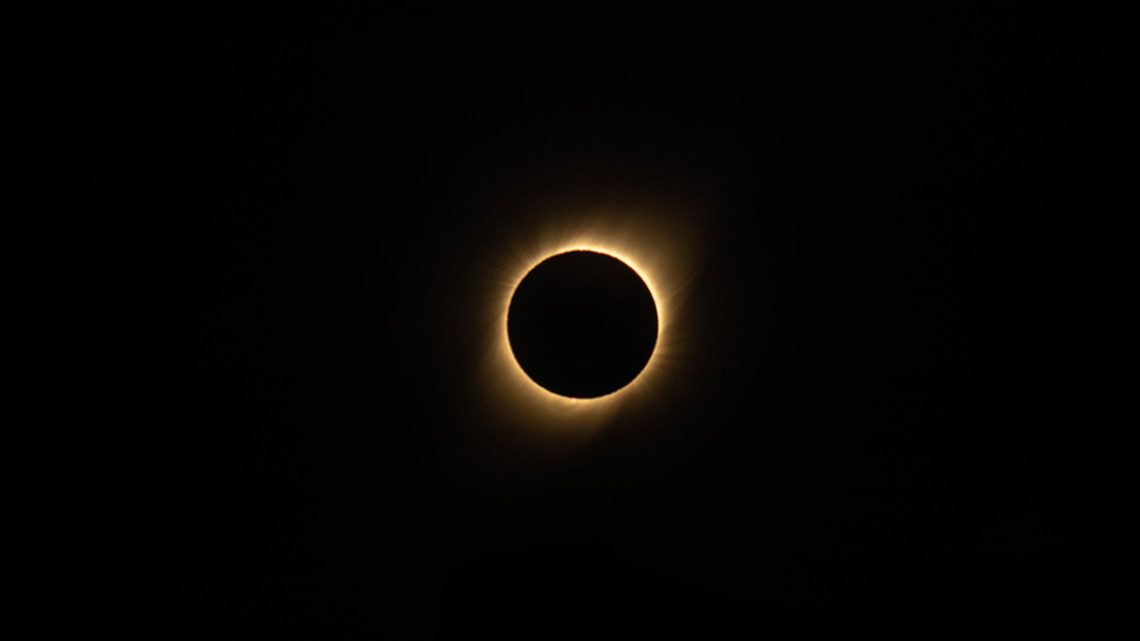
Moon in front of the sun during a solar eclipse
How much of the Earth is covered by shadow during a solar eclipse? Is the shadow uniform, or does it have darker and lighter areas?
It’s time to experiment and create our own simulation of a solar eclipse to answer these questions!
Safety
Before you begin, consider these safety precautions:
Additional safety considerations:
- Be careful in the dark and make sure you cannot trip on any materials on the floor.
- Ask an adult before using materials.
Hands-on Science
Solar eclipse simulation
For this experiment, we will be creating and observing simulations of a solar eclipse.
Complete the Lab sheet: Solar Eclipse Simulation in your notebook or using the following fillable and printable document. If you would like, you can use speech-to-text or audio recording tools to record your thoughts.
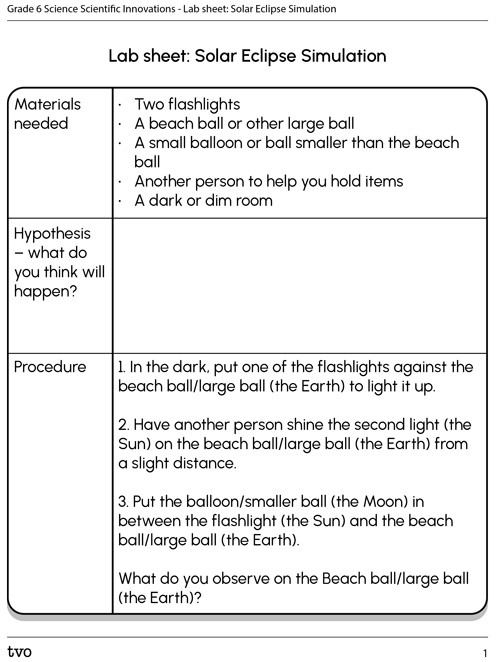
Press the Activity button to access the Lab sheet: Solar Eclipse Simulation.
Activity (Open PDF in a new tab)Press the following tabs to access the materials and procedure for the Solar Eclipse Simulation experiment.
If you do not have access to materials, access the “Video demonstration” tab to explore demonstrations of a solar eclipse. You can use the videos to make your observations and draw your conclusions.
- two flashlights
- a beachball
- a balloon or ball smaller than the beachball
- another person to help you hold items
- a dark or dim room
- In the dark, put one of the flashlights against the beachball (Earth) to light it up.
- Have another person shine the second light (the Sun) on the beachball (Earth) from a slight distance.
- Put the balloon or smaller ball (Moon) in between the flashlight (Sun) and the beachball (Earth).
What do you observe on the beachball (Earth)?
Examine the following video to explore demonstration of a solar eclipse. You may use the video to help you answer the experiment questions if you do not have access to materials.

Science is about reflecting and reimagining. Was your experiment successful?
Is there anything that you would change about your experiment design to improve it or the outcome?
Even if your experiment was not successful, what did you learn or confirm about the topic you were investigating?
Drawing conclusions
In your notebook, or using another method of your choice, such as in print, digitally or using an audio recording, answer the following questions:
- How much of the Earth is covered by shadow during a solar eclipse?
- Is the shadow uniform, or does it have darker and lighter areas?
- Explain, in your own words, what a solar eclipse is and how it happens.
Consolidation
The Sun, Earth, and Moon

Let’s take some more time to compare and review the Sun, Earth, and Moon and their relative positions to each other.
For each sentence, select the missing word from the drop-down menu.
Test Your Skills
Apply your learning!
In your notebook or using a format of your choice, identify each of the Sun, Earth, and Moon as either objects that emit light or objects that reflect light. Explain your answer for each and try to include a labelled diagram to support your thinking.
Reflection
As you read through these descriptions, which sentence best describes how you are feeling about your understanding of this learning activity? Press the button that is beside this sentence.
I feel…
Now, record your ideas using a voice recorder, speech-to-text, or writing tool.
Want to learn more?
Want to keep exploring solar eclipses? Press ‘Discover More’ to extend your skills.
Discover MoreBuild a solar eclipse viewer
Did you know you are not supposed to stare directly at the Sun? It is extremely dangerous to do so and could cause permanent eye damage! The sun emits UV (ultraviolet) rays that can be harmful to the skin, eyes and immune system.
Want to view the next solar eclipse safely?
Extend your learning by building an eclipse projector!
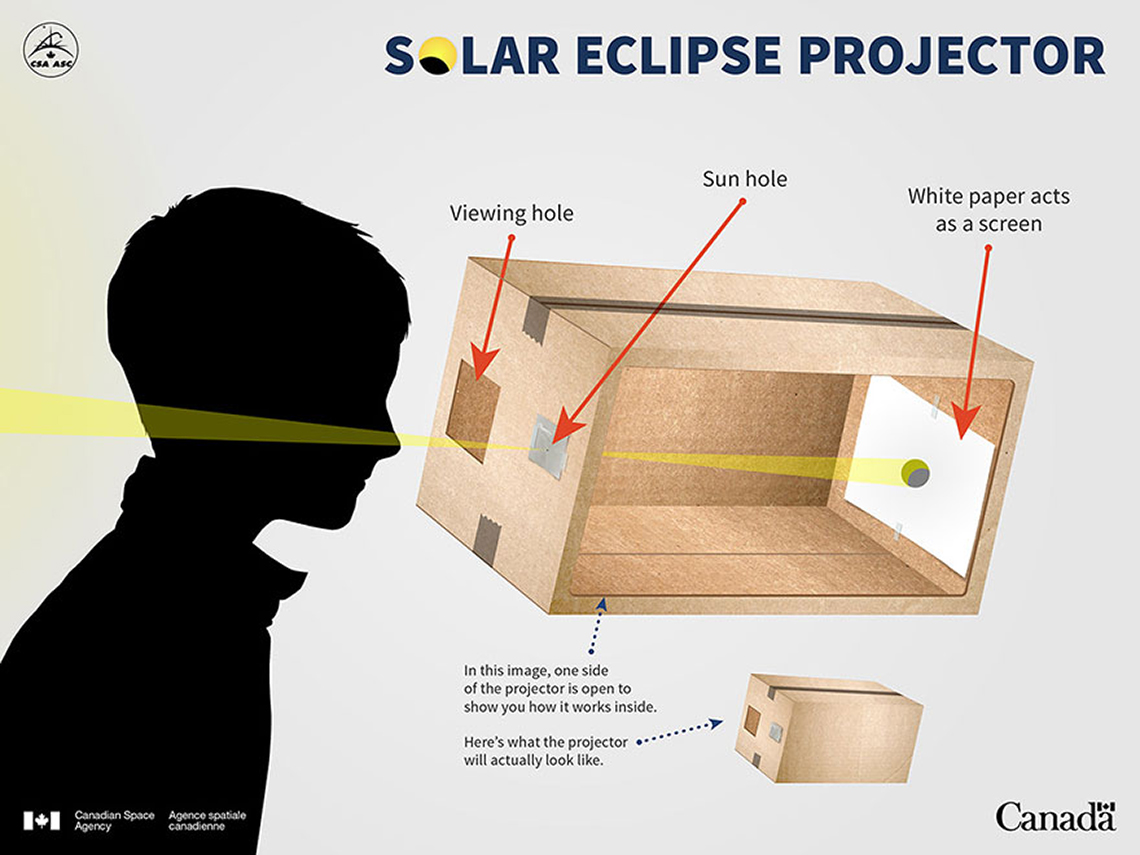
A diagram of a homemade solar eclipse projector from the Canadian Space Agency. The silhouette of a child looks through a small cut-out section, labelled the “viewing hole”, on the short side of a rectangular cardboard box that is otherwise fully sealed. To the right of the viewing hole is the labelled “sun hole” which is a small pinhole poked through a piece of tape and the box. The diagram shows one of the long sides of the box open and states “In this image, one side of the projector is open to show you how it works inside”. It also provides an image of the fully sealed length of the box and states “Here’s what the projector will actually look like”. Inside the open-sided diagram, opposite the side with the viewing hole and sun hole, a white piece of paper is taped. A label pointing to it states “White paper acts as a screen”. A beam of yellow light is shown shining through the sun hole and projecting the image of a grey circle with a yellow crescent shape on its left side in the centre of the white paper.
Materials:
- an empty cardboard box (the longer it is, the larger the image of the Sun)
- white paper
- scissors
- aluminum foil
- a pin
- tape
How to build your projector:
- Open the box and using tape, cover one of the inner sides with white paper.
- On the opposite side of the white paper, cut two holes side by side and at least 10 cm apart (one for the Sun, the other to look in).
- Cover the Sun hole with aluminum foil and tape it in place.
- Grab your pin and poke a tiny hole in the aluminum foil.
- Seal the box tightly.
- Decorate the outside of your new projector to make it your own! (optional)


